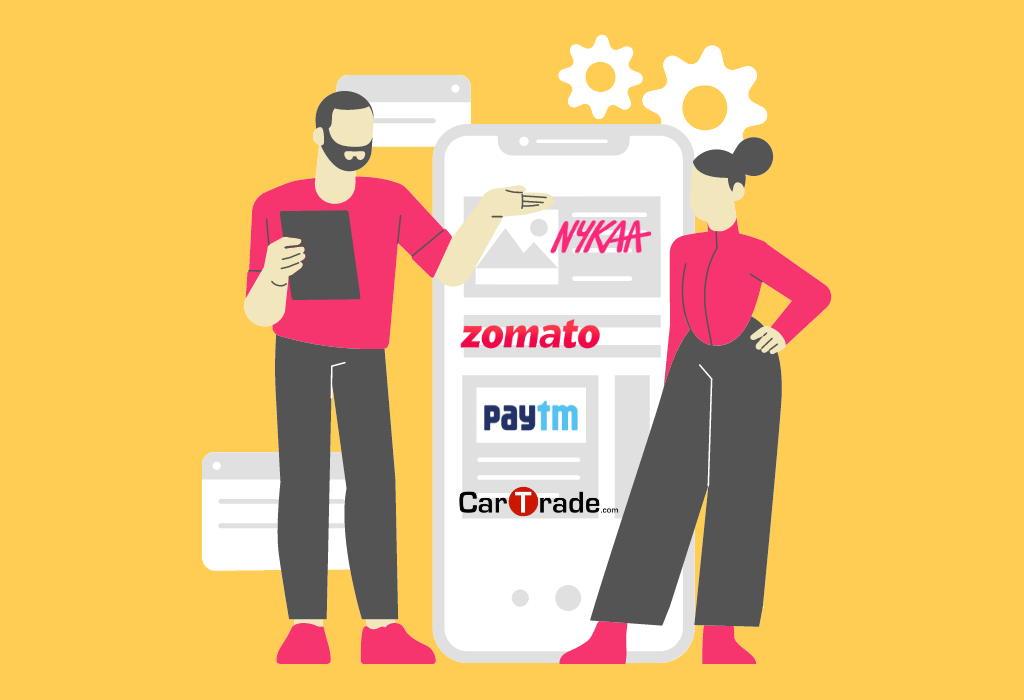2021 was an excellent year for the stock markets. So, many companies filed for their Initial Public Offerings (IPOs). We also saw a list of new-age startups turned unicorns list on the stock markets last year. We are talking about Zomato, Nykaa, Policybazaar, Paytm and CarTrade.
Zomato had a smashing Dalal Street debut and Nykaa, Policy Bazaar’s parent PB Fintech, Paytm’s parent One 97 Communications and CarTrade followed it. Until last year, the stock markets never saw such new-age listings on the stock markets.
Earlier, a company would need consistent profits, tangible assets, positive cash flows, etc., to attract significant bids from investors. However, most tech-based companies received applications multiple times their actual issues despite recording losses and negligible physical presence.
The IPO performance of recently listed new-age companies.
| Company | IPO Subscription (Times) | Issue Price | Listing Price | Listing Gains |
| Nazara Technologies | 175.46x | ₹ 1,101.00 | ₹ 1,990.00 | 81% |
| EaseMyTrip | 159.33x | ₹ 187.00 | ₹ 206.00 | 10% |
| Nykaa | 81.78x | ₹ 1,125.00 | ₹ 2,001.00 | 78% |
| Zomato | 38.85x | ₹ 76.00 | ₹ 115.00 | 51% |
| CarTrade | 20.29x | ₹ 1,618.00 | ₹ 1,600.00 | -1% |
| PB Fintech | 16.59x | ₹ 980.00 | ₹ 1,150.00 | 17% |
| Paytm | 1.89x | ₹ 2,150.00 | ₹ 1,955.00 | -9% |
| Delhivery | 1.63x | ₹ 487.00 | ₹ 493.00 | 1% |
Except for Paytm and CarTrade, the other six listed at prices higher than their issue prices. You see, the investment space is changing. Companies’ business models are evolving. Businesses are moving from tangible assets to intangible assets using tech. They are transitioning from capital to tech extensivity. And investors seem to be welcoming these new ideas.
So, it is safe to say that the future belongs to such disruptive ideas and we will see many of them making stock market debuts. But, while this is true, you may have plenty of questions and thoughts.
Almost all listed new-age companies are down 50-60% from their all-time highs, so should you trust them? Are they any good? And if they are, how do you identify which company is worth your money?
Before you understand how to pick good opportunities, let’s understand more about new-age companies.
What Are New-Age Companies?
New-age companies have emerged from users’ problems that traditional companies could not resolve. These companies rely heavily on innovative technologies to address a niche need of their target audience. While traditional businesses look to grab market share in existing industries new-age companies tend to create a market and dominate it.
Because having market dominance helps a business achieve a significant valuation premium that lets them raise more capital from venture capitalists. New-age business models are marketplaces, feeds, subscriptions, platforms, and aggregators.
The table below lists a startup, the need it addresses and its business model.
| Startups | Need they address | Business Model |
| Zomato | Food delivery | Restaurant aggregator/Ecommerce |
| Zepto, Dunzo | Instant grocery delivery | Marketplace/Ecommerce |
| PharmEasy, 1MG | Medicine Delivery | Marketplace/Ecommerce |
| LazyPay, Slice | Instant Financing | Lending Platform |
| Trivago | Hotel booking | Hotel aggregator |
| Zee5, Voot | Entertainment at home and anywhere | Subscription |
Since these companies follow an evolved business model, it is impossible to study them using a mainstream approach followed to learn more about traditional asset-heavy firms. Moreover, you can’t research such companies using a single method. Each firm is at a different evolution stage.

However, you can consider several Key Performance Indicators (KPIs) to Identify Good New-Age Companies to Invest In.
TAM and SAM
A Total Available Market or TAM is a crucial indicator to gauge the business potential of new-age companies. Thus, the bigger the addressable market base, the more opportunities.
Look at Zomato, for instance. The food-tech startup’s TAM is huge. Almost every person living in mega and metro cities with access to the internet and smartphones is likely to order food using Zomato’s delivery services.
Nykaa, a fashion and beauty e-commerce site, has a vast but relatively lesser TAM than Zomato. It has an extensive user base of women. However, they have introduced a separate website called Nykaa Man to get the male audience to shop on the website, adding to its TAM.
SAM stands for Serviceable Available Market. Look at Zomato’s presence in Mumbai. The whole of Mumbai is the TAM for Zomato.
But, not everyone in Mumbai may order food from the platform. For example, 10% of the population may not order food because it only prefers home-cooked food, 5% may only go to restaurants to eat food, and another 8% will not be able to order food because they can’t afford it. So, the SAM for Zomato is 77% (100-23).
Active and Non-Active users
While TAM helps you guess to ‘how many’ new-age firms can reach, a sum of Active and Non-Active or Transacting and Non-transacting users indicates the number of users a company has managed to acquire. For a mobile app-based platform, the approximate number of total users can be based on the number of downloads. E.g. Cred, a credit card payment platform, has over 10 Million downloads.
All new-age companies spend a lot of money on discounts, freebies, attractive welcome kits, cashback, etc. to acquire users and get them to transact. As a result, they attract a large pool of users; however, the problem arises when these users stop using the services after the first transaction dividing the pool into two – Active users and Non-active users. It’s a matter of concern if non-active users are higher than active users.
CLV and CAC
CLV, a short form for Customer Lifetime Value, is an important metric to determine the future income of a new-age business. For example, if a yearly subscription to an OTT platform is Rs. 200 and a customer uses the services for the next ten years, then the CLV of that customer would be Rs. 2000 (Rs. 200 x 10 years) for the OTT platform.
Please note that the CLV is just an indicative figure and can’t be considered the exact revenue a company can generate in the future from a particular customer.
CAC stands for Customer Acquisition Cost. Acquisition cost here means the total money a company spends to acquire each new customer. It includes freebies, discount coupons, cashbacks, and other frills. Divide the sales and promotion expenses by the number of customers acquired to calculate CAC.
For example, Company ABC acquired 10 customers. The cost of sales was Rs. 1000 and the company spent Rs. 75 each to acquire customers. The cost of acquisition would be Rs. 175 (Rs. 1000 + 750/10).
If the CAC is higher than CLV, a company is considered a bad pick.
GMV and AOV
GMV stands for Gross Merchandise Value, while AOV is Average Order Value. GMV calculates the total value of sales. AOV measures the average amount a customer spends each time a purchase is made. You can arrive at GMV by multiplying AOV with the total number of transactions. Consider transactions because the same customer can complete more than one transaction.
Several new-age companies those involved in the payments business (PhonePe) consider Gross Transactional Value (GTV) as GMV.
In addition to the above KPIs, you must consider the market share of new-age companies in the SAM. Per our research, Nykaa has ~30% market share in the online Beauty and Personal care (BPC) segment, and Zomato claims ~50% of the online food delivery market.
While new-age companies need to attract new customers to gain a sizeable market share, a high percentage of repeat orders, i.e., new or re-orders from the existing customers, implies that the customers are satisfied with the business and prefer sticking to it. Therefore, it is a matter of concern if the repeat orders decrease though new customer acquisition is in full swing.
Due to the fast-evolving technology and shifting consumer preferences, an existing new-age business may become irrelevant tomorrow. So, these companies are constantly searching for small emerging start-ups to invest in or acquire. As the deliver-to-home model gets mainstream, new entrants are betting on fast(er) delivery to make a dent in the industry. Hence, Zomato has bought a stake in a small related start-up, Blinkit. This behavior implies that the company wants to stay relevant in the long term.
Last but not least is path to profitability. Except for Nykaa, start-ups turned unicorns listed in the previous year, none of them are profitable yet. But at some point, they must turn profitable as that’s the core business need to sustain for an extended period. So, how do you know if the company will be profitable?
Look at the contribution margin that gauges per unit profit. You can calculate this metric by subtracting variable costs such as incentives, logistics, cashback, etc., from revenues. It’s crucial that new-age companies eventually increase their contribution margin/profit as the business scale grows and the company matures.
We hope now you understand what investment strategy you can rely on while identifying new-age businesses that are worth your time and money. No worries if you still find it overwhelming to identify the right stocks to build a sturdy portfolio.
Subscribe to our wealth advisory services and let our equity experts with a collective experience of over 100 years build a portfolio of fundamentally sound stocks.
*Disclaimer: Information mentioned in this article is for educational purposes. Please do not consider it a recommendation to buy/sell/hold from Research & Ranking.
Read more: About Research and Ranking
How useful was this post?
Click on a star to rate it!
Average rating 0 / 5. Vote count: 0
No votes so far! Be the first to rate this post.
I’m Vinay Mahindrakar, an experienced content creator with
an affinity for writing on personal finance and other financial content. I
love to write on equity investing, retirement, managing money, and more.
-
Vinay Mahindrakarhttps://www.equentis.com/blog/author/vinay/
-
Vinay Mahindrakarhttps://www.equentis.com/blog/author/vinay/
-
Vinay Mahindrakarhttps://www.equentis.com/blog/author/vinay/
-
Vinay Mahindrakarhttps://www.equentis.com/blog/author/vinay/



